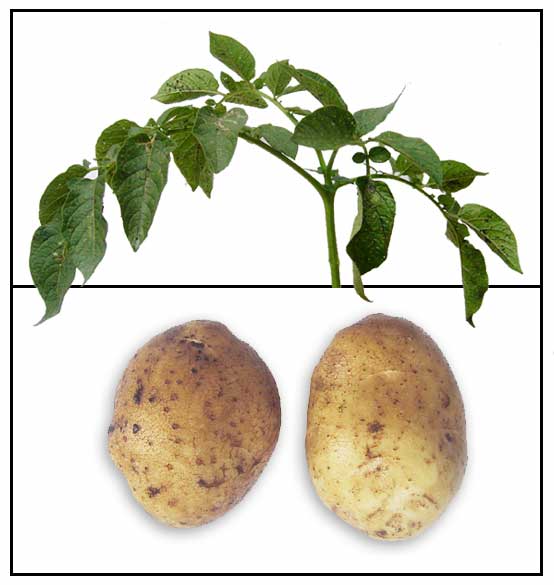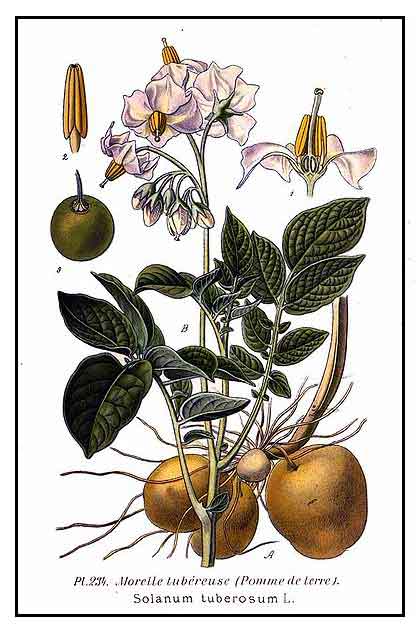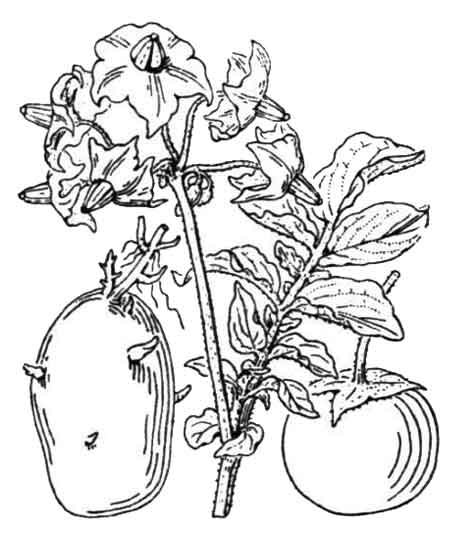
Botany
Patatas is a perennial herb with rough, pinnate leaves. Flowers are rather large,
white or purple, star-shaped, and borne on compound inflorescences, 3 to 4 centimeters in diameter. Roots grow round and edible fleshy tubers.
 Distribution Distribution
- Cultivated at higher altitudes, especially in the Mountain Province, Luzon, and in the Lanao region in Mindanao
- Introduced from America.
Constituents
• The entire plant contains toxic glycoalkaloids but usually in harmless quantities in the edible tubers. (9)
•
Study yielded a gluco-alkaloid, solanine, in the fresh plant, 0.0101 to 0.0489 %; flowers, 0.6 to 0.7 %; unripe fruit, about 1 %; seeds, 0.25 %; tubers and buds, 0.02%; skin, 0.07%, starchy region, 0.002%; shoots, 0.02 to 0.05%.
• Sprouting, growing tubers are considered poisonous, as well as the flowers, unripe seeds, and leaves as they contain solanine. The full-grown tuber does not contain solanine.
• Study isolated putrescine N-methyltransferase, a calystegine,a
nortropane alkaloid with glycosidase inhibitory activity. (9)
- Study of fresh unripe fruit yielded α-chaconine, α-solanine, and chlorogenic acid.
Aerial parts yielded α-chaconine, α-solanine, aculeatiside A and B. Tubers yielded α-chaconine, α-solanine and protodioscin. (13)
•
Analysis of nutritive value of potatoes, fresh and skin, all varieties, per 100g yielded: (Principle) energy 77 Kcal, carbohydrates 17.49 g, protein 2.05g, cholesterol 0, dietary fiber 2.1g; (Vitamins) folates 15 mcg, niacin 1.061 mg, pantothenic acid 0.278 mg, pyridoxine 0.298 mg, riboflavin 0.032 mg, thiamin 0.081 mg, vitamin A 2 IU, vitamin C 19.7 mg, vitamin K 2 mcg; (Electrolytes) sodium 6 mg, potassium 425 mg; (Minerals) calcium 12 mg, iron 0.81 mg, magnesium 23 mg, manganese 0.141 mg, phosphorus 57 mg, zinc 0.30 mg; (Phytonutrients) carotene-ß 4 mcg, cryto-xanthin-ß 0 mcg, lutein-xanthin 21 mcg. (USDA National Nutrient data base) (16)
Properties
• Antiscorbutic,
aperient, diuretic, galactagogue, stimulant, emollient, antidote, antispasmodic.
• Considered a nervous sedative and stimulant in gout.
• Leaves believed to be poisonous.
• Studies have shown antioxidant, antibacterial, anticonvulsant, corrosive inhibition, anti-ulcer properties.
Uses
Edibility / Nutritional
- Very high starch content; valuable as an energy-giving food.
- Potatoes grown in Baguio are deficient in calcium, and only fair sources of iron.
-
Good source of fiber,
vitamins B and C, and minerals.
- Peels are high in potassium.
- Although foliage is considered poisonous, some African tribes used the tip as a potherb. (20)
Folkloric
- Gently laxative, but non-purging.
- Promotes milk.
- Useful for gout.
- Potato-peel tea for hypertension.
- Poultice of leaves as a tonic.
- Used for scurvy, dyspepsia, hyperacidity, gout and arthritis.
- Decoction of leaves for chronic cough.
- Potato, ground to a paste, applied as a plaster to burns caused by fire.
- Poultice of grated raw potato used for light burns, arthritis, itching,
etc.
- Boiled potatoes used as emollient poultices.
- Used as antidote to poisoning by iodine.
- Extract of leaves used as an antispasmodic in chronic coughs, producing opium-like effects. Extract also used as a narcotic.
- In Tanzania, raw potato tubers are squeezed and juice applied as eye drops to improve poor vision. (12)
- In traditional medicine of Europe, raw potatoes are used for gastrointestinal disorders, and topical potato preparations are used as hot packs for pain or for softening of furuncles. (19)
- Tea prepared from peels of tubers used as folk remedy for tumors. Boiled tuber used to alleviate corns. Powdered tuber, with copper sulfate, used to help callused fistulas. Europeans used to tie raw potatoes behind the ears for delirium. (20)
- Juice prepared from tubers used for treatment of peptic ulcers. Warm juice applied to rheumatic joints. swellings, skin rashes, hemorrhoids. Peeled uncooked potatoes pounded and applied as a cold soothing plaster to burns and scalds. In India, potato skins used to treat swollen gums and burns. (21)
- Raw potato cataplasm used for burns, frostbite, cracks, ulcers, swelling of eyelids. (21)
Others
- Fodder: Potato surplus used for fodder. Animals fed large residues of raw or cooked potato or "distiller's slop" develop a potato eruption. (see toxicity below)
- Alcohol: Boiled with weak sulfuric acid, potato starch is changed into glucose fermented into alcohol, "British Brandy." (20)
- Cleaner: Ripe potato juice excellent for cleaning cottons, silk, and woolens. (20)
- Cosmetics: (1) Facial mask: The National Potato Board has recommended using peeled, shredded, and soaked potatoes as a facial mask for drying oily skin. (2) Anti-aging: Washing the face daily with potato juice (raw potato ground with water) may prevent wrinkles on the face and make the face glow. (3) Skin cleanser and revitalizer. (4) Potato water used for removing freckles. AzelIc acid from potato is alleged to inhibit tyrosinase activity to reduce pigmentation spotting related to breakouts, treats mild to moderate acne, reduced bacterial growth in the follicles. (21)
Studies
• Antioxidant: A 2006 study of commonly
consumed roots crops in the Philippines – Kamote (Ipomoea
batata); ubi, purple yam (Dioscorea
alata); cassava (Manihot esculenta); taro or gabi (Colocasia
esculenta); carrot (Daucus carota); yacon (Smallanthus sonchifolius)
showed them to be rich sources of phenolic compounds with antioxidant
activity, highest in sweet potato, followed by taro, potato, purple
yam and lowest in the carrot. (2)
 • Anticonvulsant:
A study showed potato juice exerted significant anticonvulsant activity
in mice. It suggests that potato juice, as well as potato, may influence
brain GABA-activity. (1) • Anticonvulsant:
A study showed potato juice exerted significant anticonvulsant activity
in mice. It suggests that potato juice, as well as potato, may influence
brain GABA-activity. (1)
• Teratological and Toxicological Studies:
Study was done on the effects of acute and chronic administration in pregnant and non pregnant rats of alkaloidal, glycoalkaloidal and phenolic compounds from Solanum tuberosum. None of the compounds produced neural tube defects; a few fetuses had rib abnormalities. (4)
• Antiobesity of New Purple Potato Variety:
Study of a purple potato variety showed anti-obesity potential via inhibition of lipid metabolism through p38 MAPK and UCP-3 pathways.
• Anti-Adhesion / Antimicrobial Properties: A study showed S tuberosum has the potential of interfering with the adhesion of oral bacteria. Also, S tuberosum methanolic extract showed a greater then 25 mg/ml MIC value against S epidermis, S typhi and B subtilis. (6)
• Antioxidant / Peels: Study investigated in-vitro hydroxyl and NO, DPPH radical scavenging activities and total phenolic content of S. tuberosum peel extracts. Results showed an ethyl acetate extract to contain higher amounts of polyphenolic contents compared to the methanol extract. DPPH radical scavenging activity was dose-dependent . (7)
• Corrosion Inhibition: Study of an acid extract of Solanum tuberosum showed potential as a corrosion inhibitor for mild steel which may be due to adsorption of alkaloids and other phytoconstituents. (8)
• Putrescine N-Methyltransferase: Potatoes yield calystegines,
nortropane alkaloids with glycosidase inhibitory activity. Based on calystegine formation by the tropane alkaloid pathway, study investigated PMT genes and enzymes. Sprouting tubers contain both N-methylputrescine and PMT activity. Results confirm potato genes and enzymes specific for the tropane alkaloid metabolism are expressed and active. (9)
• Antibacterial / Peel: Study investigated the in vitro antibacterial effects of S. tuberosum ethanol extract of peels. Results showed antibacterial properties more pronounced on gram-positive bacteria, especially S. aureus. (10)
• Anti-Ulcer
/ Tubers: Study evaluated the potential of S. tuberosum for anti-ulcer activity in pylorus-ligation model and stress-induced ulcers by cold water immersion. Results showed both alcoholic extracts and aqueous extracts of tubers possess anti-ulcer activity. Phytoconstituents tannins, flavonoids, and triterpenes reported to have anti-ulcer activity were present in both extracts. LD50 was 2000 mg/kg body weight. (11)
• Solanine / Antibacterial / Leaves: Study isolated solanine from leaves of potato plant leaves. The solanine showed effective inhibition against Bacillus subtilis and slight inhibition against Staphylococcus aureus. (15)
• Effect on Organ Weight and Hepatic Oxidative Stress in Obese Rats / Peel or Pulp: Study evaluated the effect of consumption of peel flour or pulp flour on accumulation of adipose tissue, organ weight, and oxidative stress in the liver of obese Holtzman rats. Enzyme activity of superoxide dismutase and catalase were measure in the liver. Obese rats that consumed the pulp of Yungay potato variety had less oxidative stress in the liver. (17)
• Wound Healing / Ointment Formulation / Peel and Pulp of Tubers: Study evaluated the healing activity of an ointment formulation prepared from ethanolic extracts of peel and pulp of tubers on wounds induced in mice. Results showed treated groups had better evidence of wound closure and scarring in the histopathological analysis. The 2% ointment formulation showed most effective results. (18)
• Potato-Derived Products / Review: Study reviewed the literature and summarized data on medicinal use of potato-derived products. Five trials were identified: two open uncontrolled studies two open controlled studies and one double-blind study. Results stimulate further studies of oral juice concentrate in patients with dyspeptic conditions, of potato proteinase inhibitor II for weight reduction, and topical potato proteins for preventing protease-induced perianal dermatitis. Review suggests studies with confirmatory design. (19)
• Potato Masks / Topical Therapy for Acne:
Study evaluated the use of potatoes as external anti-acne agent. Potato masks are prepared from potatoes which are mashed with a blender to a porridge state. Results showed the use of potato masks can result in reduction of mild acne on facial skin. (22)
• Antifungal / Peels: Study evaluated the antifungal activity of crude glycoalkaloid extract (concentration 833.33 microgram/mL) from Solanum tuberosum L. (white potato) peelings against opportunistic fungi Candida albicans, C. glabrata, Aspergillus niger, A. fumigatus, and A. flavus. The extract showed an MIC of 104.17 microgram/mL for A. flavus, verifying the antifungal effect of glycoalkaloid. (23)
• α-Solanine / Toxicity, Teratogenicity / Anticancer Potential: α-Solanine is a glycoakaloid metabolite produced by solanaceae species. It is highly toxic to animals and humans and is a risk factor for developing congenital malformations. Recent studies have suggested α-solanine possess antimicrobial and anti-tumor activities. Review summarizes the main properties of α-solanine, toxicity and teratogenicity in animal models, and reported anticancer activity against various cancer cell lines in invitro assays. (25)
Toxicity !
Potato poisoning
• Occurs when someone eats the green tubers or new sprouts of
the potato plant. The poisonous ingredient is Solanine
which is very toxic even in small amounts. Potatoes should never be
eaten when spoiled or green below the skin. Sprouts should always be
discarded.
• Symptoms: Delirium, diarrhea, dilated pupils, fever or hypothermia,
hallucinations, headache, numbness, paralysis, shock, vision changes,
vomiting.
- Potato with green discoloration as a result of exposure to the sun, contains solanine and has been known to cause fatal poisonings (Watt and Breyer-Brandwijkm 1962) (20)
• Treatment: Do not attempt home treatment or alternative remedies. Seek immediate medical help. Depending on severity, treatment might necessitate use of activated charcoal, breathing support, IIV fluids and gastric lavage. (3)
Leaves toxicity
• Potato leaves are generally considered toxic. Its use as food is a restricted custom in high mountain communities where the availability of fresh herbs is restricted by long winters, and at times, it may serve as emergency staple. Toxicity is less in young leaves, and preparations that leach out toxins is evidence of adaptive ingenuity of mountain populations.
Availability
Wild-crafted use of
leaves.
Cultivated for the potato.
|


![]()

